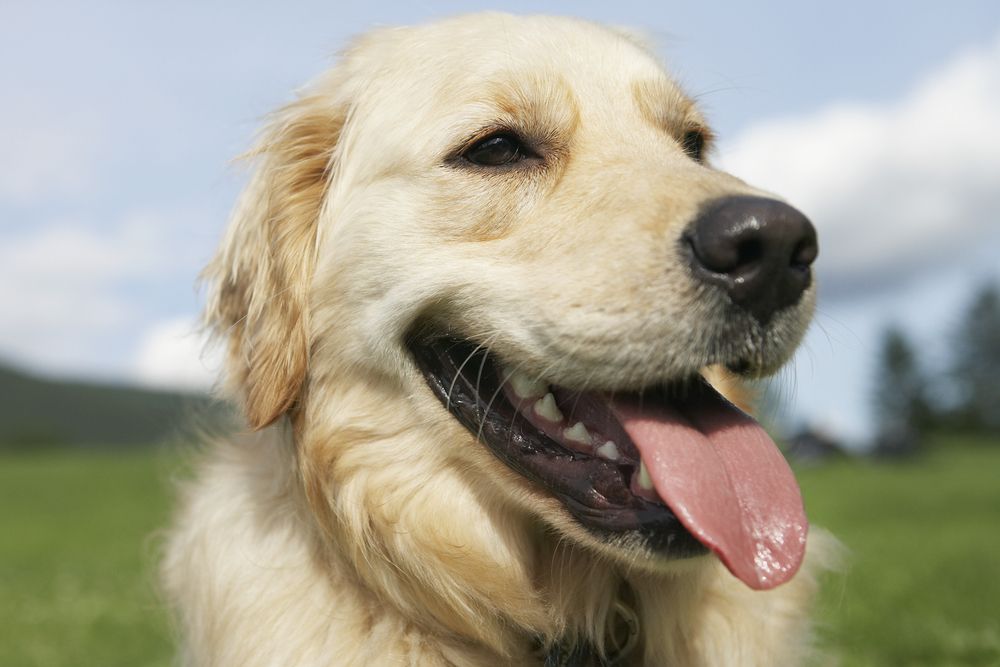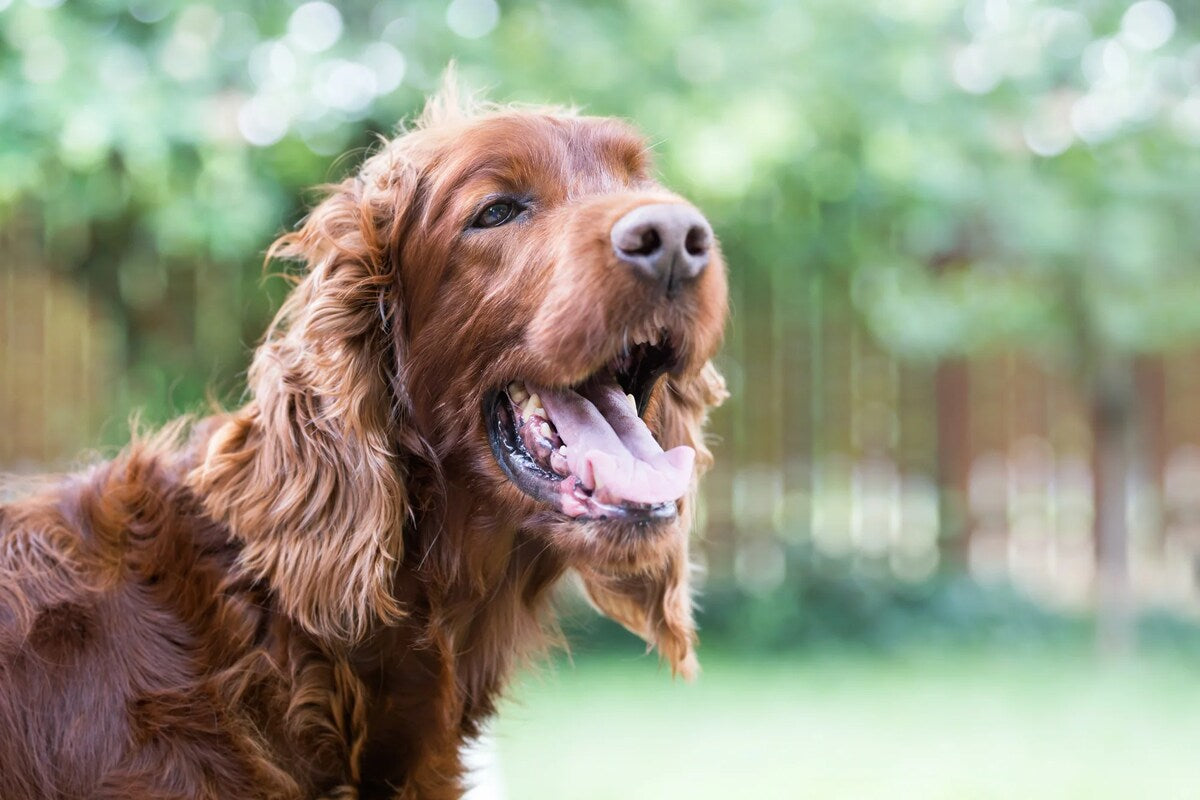Dogs panting is a common behavior that owners often observe in their furry companions. While panting is a natural way for dogs to regulate their body temperature, there are various reasons why dogs pant excessively or in unusual circumstances. In this comprehensive guide, we’ll explore the mechanisms behind dog panting, the normal range of panting behavior, and the potential underlying causes of excessive panting.
Understanding Dog Panting

Normal Panting Behavior:
- Panting as a Cooling Mechanism: Dogs lack sweat glands over most of their bodies, so they rely on panting as their primary method of cooling down. When a dog pants, moisture from their tongue and the lining of their respiratory tract evaporates into the surrounding air, carrying heat away from their body.
- Breathing Rate: A healthy dog typically breathes at a rate of 15 to 35 breaths per minute while at rest. However, during physical activity or exposure to heat, panting increases to facilitate cooling. It’s important for pet owners to be familiar with their dog’s normal breathing patterns to recognize when panting becomes excessive.
Physiological Process of Panting:
- Convection Cooling: Panting works through a process called convection cooling. As a dog breathes in and out, air passes over the moist surfaces of their tongue and upper respiratory tract. This moist air evaporates, carrying away heat from the dog’s body and helping to lower its internal temperature.
- Heat Dissipation: Through panting, dogs release heat from their bodies in the form of water vapor. This evaporative cooling process allows dogs to dissipate excess heat and maintain a comfortable body temperature, especially in hot environments or during physical exertion.
Common Causes of Excessive Panting

Medical Conditions:
- Anxiety: Dogs may pant excessively due to anxiety or stress. Situational stressors such as loud noises, unfamiliar environments, or separation from their owners can trigger heightened panting. Chronic anxiety may require behavioral interventions or medication.
- Respiratory Issues: Various respiratory conditions can lead to heavy or labored breathing in dogs. Conditions such as asthma, kennel cough, or laryngeal paralysis can restrict airflow and cause excessive panting. Prompt veterinary evaluation and treatment are necessary to manage respiratory conditions effectively.
- Heat Stroke: In hot environments or during strenuous exercise, dogs are at risk of heat stroke, a life-threatening condition characterized by excessive panting, lethargy, drooling, and collapse. Immediate cooling measures and veterinary intervention are crucial to prevent complications and organ damage.
Environmental Factors:
- Exercise: Intense physical activity can cause dogs to pant heavily as their bodies work to supply oxygen to active muscles. While panting during exercise is normal, persistent or excessive panting after activity may indicate fatigue or overheating. Providing adequate rest and hydration is essential to prevent exhaustion.
- Heat and Humidity: Dogs are susceptible to heat exhaustion and dehydration in hot and humid conditions. Panting helps them dissipate heat, but prolonged exposure to high temperatures can lead to heat-related illnesses. Owners should ensure access to shade, water, and cooling measures during hot weather to prevent heat-related emergencies.
Breed-Specific Considerations:
Brachycephalic Breeds: Dogs with short muzzles, such as Bulldogs, Pugs, and Boxers, are prone to respiratory issues due to their unique facial anatomy. Brachycephalic breeds may experience difficulty breathing, especially in hot or humid weather, leading to excessive panting. Owners of brachycephalic breeds should monitor their pets closely and seek veterinary care for respiratory symptoms.
Recognizing Signs of Distress

When to Be Concerned:
- Abnormal Panting: Owners should monitor their dog’s panting behavior and be alert to any changes. Excessive panting, especially when accompanied by other symptoms such as lethargy, weakness, or loss of appetite, warrants prompt veterinary attention. Additionally, panting that persists despite rest or occurs in unusual circumstances may indicate underlying health issues.
- Signs of Heat Stroke: In hot weather, dogs exhibiting signs of heat stroke require immediate intervention. Rapid panting, excessive drooling, weakness, collapse, and vomiting are common symptoms of heat stroke. Owners should move their dog to a cooler environment, provide water for hydration, and seek emergency veterinary care to prevent organ damage and complications.
- Respiratory Distress: Dogs experiencing respiratory distress may exhibit alarming symptoms such as gasping for air, open-mouthed breathing at rest, or cyanosis (blue-tinged gums). These signs indicate compromised respiratory function and necessitate urgent evaluation by a veterinarian. Respiratory distress may result from various conditions, including asthma, pneumonia, or obstructive airway disease, and requires prompt diagnosis and treatment to alleviate respiratory distress and restore normal breathing.
Behavioral Changes:
- Anxiety and Stress: Dogs may pant excessively in response to anxiety-provoking situations or stressors. Signs of anxiety-related panting include pacing, trembling, restlessness, and avoidance behaviors. Owners should identify potential triggers of anxiety and implement strategies to alleviate stress, such as desensitization training, environmental enrichment, or calming supplements. Persistent anxiety may require consultation with a veterinary behaviorist to develop a comprehensive treatment plan.
- Other Signs of Discomfort: In addition to panting, dogs experiencing distress may exhibit a range of behavioral and physiological changes. These may include reluctance to move, changes in posture, vocalization (whining or whimpering), and altered appetite or drinking habits. Owners should observe their dog’s overall demeanor and seek veterinary attention if they suspect their pet is in distress.
Seeking Veterinary Care

Diagnostic Evaluation:
- Physical Examination: When a dog exhibits excessive panting or signs of distress, a thorough physical examination by a veterinarian is essential. The veterinarian will assess the dog’s overall health, including respiratory function, heart rate, and hydration status. Physical examination may reveal abnormalities such as abnormal lung sounds, cyanosis (blue-tinged mucous membranes), or signs of pain or discomfort.
- Diagnostic Tests: In cases of persistent or severe panting, diagnostic tests may be necessary to identify the underlying cause. These tests may include bloodwork to assess organ function and screen for infections or metabolic disorders. Additionally, imaging studies such as radiographs (X-rays) or ultrasound may be performed to evaluate the heart, lungs, and abdominal organs for structural abnormalities or signs of disease.
- Treatment Options: Treatment for excessive panting depends on the underlying cause identified through diagnostic evaluation. This may include medication to alleviate respiratory symptoms, intravenous fluids to address dehydration or electrolyte imbalances, or supportive care to manage underlying medical conditions. The veterinarian will develop a tailored treatment plan based on the dog’s individual needs and response to therapy.
Emergency Situations:
- Heat Stroke: Dogs experiencing heat stroke require immediate intervention to prevent life-threatening complications. Owners should move the dog to a cooler environment, provide water for hydration, and apply cool compresses or immerse the dog in cool water to lower body temperature. Prompt veterinary care is necessary to assess the extent of heat-related injuries and provide supportive treatment, including intravenous fluids and monitoring for organ dysfunction.
- Respiratory Distress: Dogs struggling to breathe or exhibiting signs of respiratory distress require urgent evaluation by a veterinarian. Owners should seek emergency veterinary care if their dog displays gasping for air, cyanosis (blue-tinged gums), or open-mouthed breathing at rest. Prompt diagnosis and treatment are crucial to identify and address the underlying cause of respiratory distress, which may include airway obstruction, pneumonia, or heart failure.
Follow-Up Care:
- Monitoring and Management: Following initial evaluation and treatment, dogs may require ongoing monitoring and management to ensure optimal recovery and prevent recurrence of panting episodes. Owners should follow the veterinarian’s recommendations for medication administration, activity restriction, and environmental modifications to promote healing and reduce the risk of complications.
- Behavioral Support: In cases where excessive panting is related to anxiety or stress, owners may benefit from behavioral support and management strategies to address underlying behavioral issues. This may include behavior modification techniques, environmental enrichment, or medication to alleviate anxiety symptoms. Veterinary behaviorists can provide guidance and support to help owners address their dog’s behavioral needs effectively.
Conclusion
Understanding why dogs pant is essential for recognizing normal versus abnormal panting behavior and identifying potential health concerns. While panting is a natural cooling mechanism for dogs, excessive panting or panting in unusual circumstances may indicate underlying medical issues or environmental stressors. By monitoring their dog’s panting behavior and seeking prompt veterinary care when necessary, owners can help ensure their furry companions stay happy, healthy, and comfortable.

